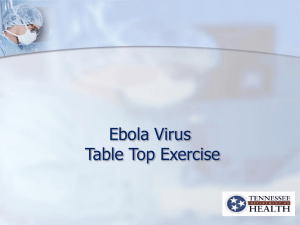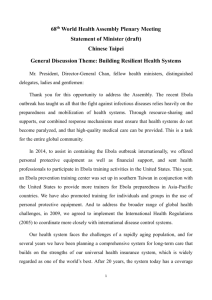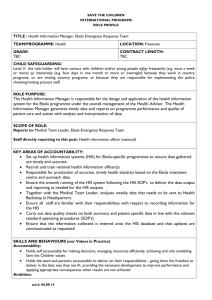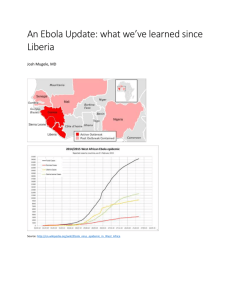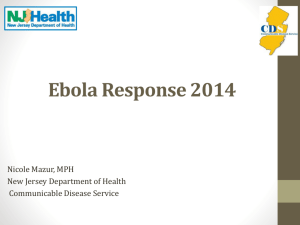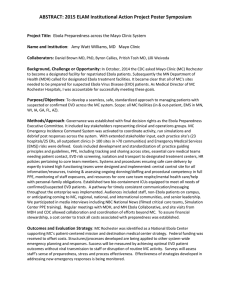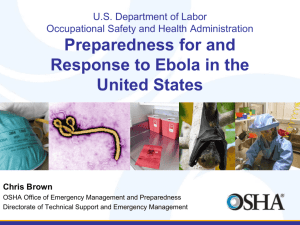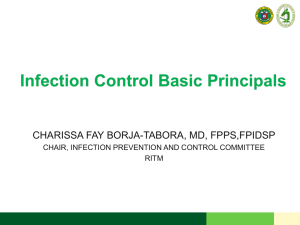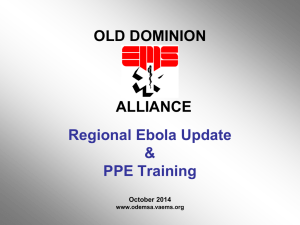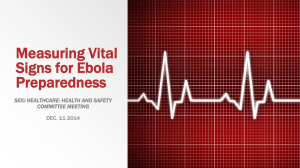MHA Ebola tabletop exercise - Missouri Hospital Association
advertisement
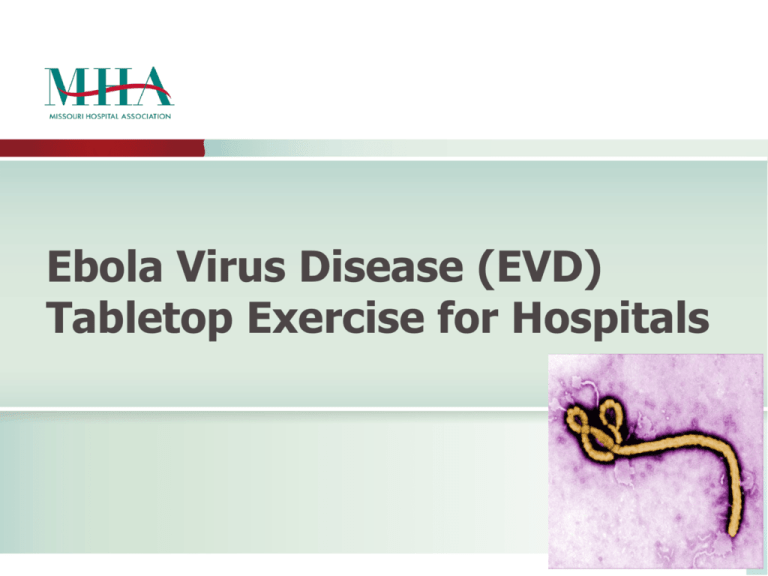
Ebola Virus Disease (EVD) Tabletop Exercise for Hospitals Purpose To provide a forum for Missouri hospitals to discuss and evaluate their level of preparedness, to include plans, equipment, and training, for a suspected Ebola Virus Disease (EVD) patient. Objectives • Detect - discuss patient detection - screening, case identification, and testing protocols • Protect - discuss infection control measures to minimize spread • Respond - Discuss critical notifications and communication, patient care, and environmental concerns • Identify gaps in preparedness for Ebola - plans, procedures, training, supplies, and equipment Exercise Instructions This is an exercise based on a possible event. Process the information just as you would in a real-life incident. Participation is the key to making this exercise a success. Feel free to make valid assumptions based on the information provided. Respond based on your knowledge of current plans and capabilities (you may use only existing assets). Rules of Engagement • This is an open, low-stress, no-fault environment. • Offer any suggestions or recommended actions that could improve response and preparedness efforts. • Be respectful of others as varying viewpoints, even disagreements, may occur. Scenario At 7pm on Friday, a 23 year-old male presented to the Emergency Department with a three-day history of fever (101.5), muscle pain and severe headache. His past medical history is unknown. Vitals/Symptoms: Temp 101.5 Headache Muscle pain Abdominal cramps The patient sat in the waiting room for 10 minutes with 15 other patients before he checked in at the registration desk. He vomited on the desk while he was speaking with the clerk at registration. Discussion Questions • How would this patient be handled at your facility? • What symptom related questions would you ask this patient? • What travel history questions would you ask this patient? • Would this patient be treated differently than the other patients in your waiting room? • Would you do anything at this point with the other patients in the waiting room? Scenario Upon further investigation, it is learned that the patient’s illness started with light fever and aches, and that he recently arrived in Missouri to attend college. He is from Sierra Leone. His trip from Sierra Leone included flights to London, Chicago, St. Louis, and a bus to the local area. The patient stayed in his dorm room for three days feeling sick before presenting to the ED. The registration clerk is very concerned that she has just been exposed to Ebola and is going to die. Discussion Questions Who will be contacted regarding this situation? What would happen with this patient at this time? How will a definitive diagnosis be made? What infection control measures would be put into place? What personal protective equipment (PPE) measures would be considered for staff? What staff would wear PPE? What infection control measures would be taken in the patient’s environment? Surfaces, cleaning Discussion Questions Is there any additional information that should be recovered from this patient at this time? Are there any additional activities that should be conducted to ensure disease containment? How is the situation being managed from an emergency management perspective? (ie. Incident Command activation) Scenario It is discovered through conversations with the roommate that the patient’s brother in Sierra Leone died from Ebola. The patient has vomiting and diarrhea and his temperature remains elevated. The patient’s roommate is also feeling bad with severe stomach cramping and is still in the dormitory. The local health department has been notified and contact tracing at the college has begun. Local and national press have arrived and are in your ED as they have heard that your hospital has a patient with Ebola. Staff working in the hospital are getting word that there is an Ebola patient in the facility and they are very worried about getting the disease. Discussion Questions What infection control requirements and instructions should be communicated to staff for putting on and removing PPE? What is your current inventory of needed PPE and testing supplies? How will the press be managed? What messages will you give to your staff? How will that be communicated? What external partner communication is occurring? Scenario The patient has tested positive for Ebola. He continues to deteriorate. A surge of patients has arrived in the ED as they were seen in your hospital earlier that week and are afraid that they have contracted Ebola from an infected waiting room. Discussion Questions How will the patient’s waste (biohazard, sheets, curtains, towels, etc.) be managed? Are there any precautions to be taken with the staff who may have been exposed? Registration staff Transporters Clinical and physical caretakers Housekeepers Lab personnel Others? Hotwash What went well? What did not go well? Gaps in plans, procedure, equipment, capabilities? Training needs identified? What do you need to do to ensure you are prepared? Sources for Information http://www.cdc.gov/vhf/ebola/ http://www.cdc.gov/vhf/ebola/pdf/hospitalchecklist-ebola-preparedness.pdf http://health.mo.gov/emergencies/ert/med/hem orrhagic.php

